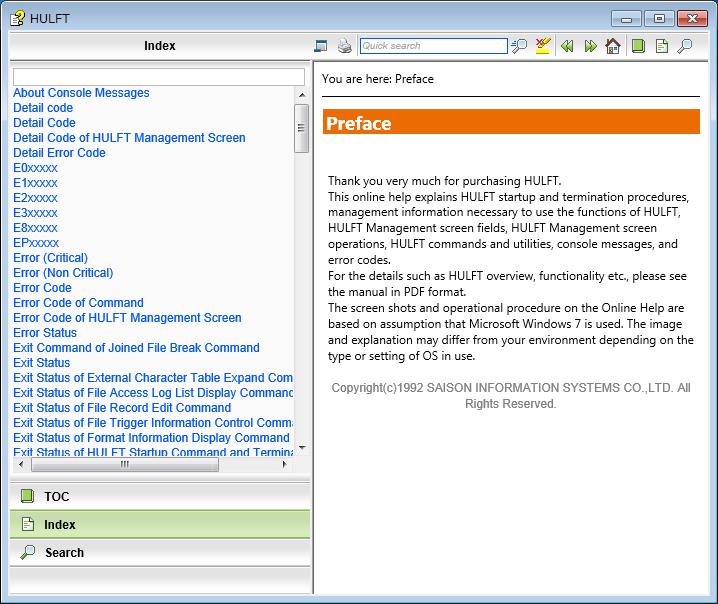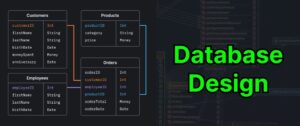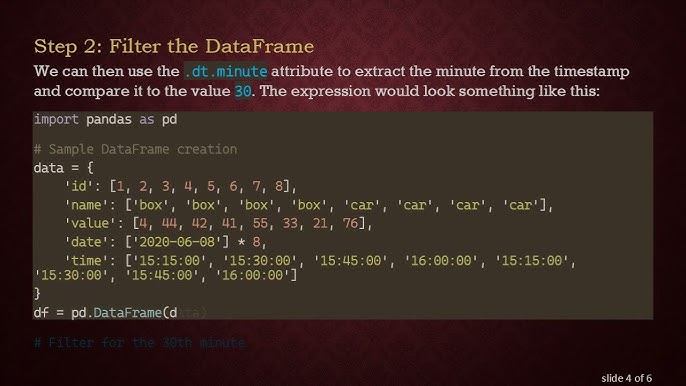datetime
library in Python and pandas, you might come across an error message stating: “Timestamp object has no attribute ‘dt’”. This issue usually happens when you attempt to access the
.dt
accessor on a Timestamp object, which is not supported.
Here is a table summarizing important points about this:
| Topic | Description |
|---|---|
| Error Message | “Timestamp object has no attribute ‘dt’” |
| Possible Cause | Attempting to use ‘.dt’ accessor on a Timestamp object |
| What it means | The ‘.dt’ accessor cannot be used directly on Timestamp objects. It’s meant to be used on datetime-like values within pandas Series or DataFrames. |
| Solution | First convert the Timestamp object into a pandas Series or DataFrame before applying ‘.dt’ accessor. |
Being aware of the distinctive distinction between a single
Timestamp()
object and a pandas Series/DataFrame filled with datetime-like data is significant. The
.dt
accessor is particularly designed to work on a whole Series of datetime-like data, offering a way to access attributes inherent to each individual date/time value.[Pandas Timestamp Documentation]
Let’s illustrate this through an example. If you have a single Timestamp object and try to execute something like this:
import pandas as pd
x = pd.Timestamp('2013-12-25')
print(x.dt.day)
You will encounter the error. Rather, correct implementation is to first convert the Timestamp into a pandas Series:
import pandas as pd
x_series = pd.Series(pd.Timestamp('2013-12-25'))
print(x_series.dt.day)
This would print out ’25’, as we’re accessing the day attribute from the datetime objects within our pandas Series.Sure, in Python, the pandas module contains a `Timestamp` object which is useful when you have to perform some operations on date-time. The `Timestamp` object can be created simply by providing it the date-time string or equivalent integer.
For illustration, consider this example:
import pandas as pd
ts = pd.Timestamp("2020-02-05")
print(ts)
The output of this program would be ‘2020-02-05 00:00:00’ which is a Timestamp object.
However, when you try to access the attribute ‘dt’ of a Timestamp object directly, like ts.dt, you will be met with an AttributeError telling you that “Timestamp object has no attribute ‘dt’” because the ‘dt’ accessor is designed for use with Series or DatetimeIndex objects but not on individual Timestamp objects. To make use of ‘dt’, a Timestamp object needs to be part of a pandas Series or a DatetimeIndex. Take this code snippet as an example:
import pandas as pd
date_series = pd.Series(
[pd.Timestamp('2020-01-01'),
pd.Timestamp('2020-02-01'),
pd.Timestamp('2020-03-01')])
print(date_series.dt.month)
With this setup, one can easily extract components of the date such as the month which returns a pandas Series with the month of each date in the series:
0 1 1 2 2 3 dtype: int64
Another more convenient use of ‘dt’ accessor involves DatetimeIndex, where you often benefit from being able to extract specific aspects of all timestamps:
import pandas as pd datetime_index = pd.date_range(start='1/1/2020', end='1/8/2020') print(datetime_index.dayOfWeek)
As a consequence, if you want to use .dt with a Timestamp to access properties like year, month, day, hour etc., about the best option is to convert the Timestamp to a datetime object first. Example.:
import pandas as pd
ts = pd.Timestamp("2020-02-05")
dt = ts.to_pydatetime()
print(dt.year)
You’ll find quite a bit more on this topic in the official pandas documentation for Timestamp and the section called Working with Time Series data in Python for Data Science, which delves into both the Timestamp object and the .dt accessor.When working with Python scripts, it’s common for developers to face a range of error messages. One commonly encountered error, especially when dealing with datetime operations in Pandas DataFrame is the
AttributeError: 'Timestamp' object has no attribute 'dt'
.
Understanding what this error message means involves understanding some key parts of Python syntax and how attributes are assigned to objects.
The first part of this error message,
AttributeError
, is a type of exception raised in Python when you try to access or call an attribute that a particular object type doesn’t possess. In layman’s terms, it’s Python’s way of telling you that you’re trying to use a function or attribute on a data type it wasn’t intended to be used on.
The second part of the error message,
'Timestamp' object has no attribute 'dt'
, tells us that we are trying to invoke the
.dt
accessor on a Timestamp object. Herein lies the problem: The
.dt
accessor can only be called on a pandas Series, not directly on a single Timestamp object.
The .dt accessor in pandas is used to access properties of Series values of the datetimelike values.Pandas Series dt
Let’s say you have a pandas series like so:
import pandas as pd
date_series = pd.Series(pd.date_range("2018-1-1", periods=3, freq="M"))
You could safely extract the day of these dates through the dt accessor:
day_of_month = date_series.dt.day print(day_of_month)
However, if you’re dealing with a single Timestamp object:
single_date = pd.Timestamp("2018-1-1")
Attempting to extract the month like you would in a Series will result in the AttributeError:
single_date.dt.month # This will raise an AttributeError
Instead you should access the property directly:
single_date.month
In conclusion, this error is caused by misapplying the
.dt
accessor to an individual
Timestamp
object where it’s designed strictly for
Series
objects possessing datetime-like values. Understanding the origin and implications of this AttributeError can aid python developers in troubleshooting their code effectively.When working with data in Pandas, Python’s robust open-source data analysis library, it’s common to encounter the challenge that a timestamp object has no attribute ‘dt’. In most cases, this arises from misunderstanding how pandas handles datetime-based operations. Pandas stores timestamps using the
Timestamp
type, which is fundamentally a single point on the global time scale.
Allow me to provide some context. All Series and DataFrames provide a
dt
accessor to the datetimelike properties for arrays of datetime-like values (source). This means, when you have a Series or a DataFrame column consisting of datetime elements, you can use this
dt
accessor followed by several datetime attributes like
year
,
month
,
day
, etc., to grab specific segments of date within your series. Here’s an example snippet:
import pandas as pd date_series = pd.to_datetime(pd.Series(['2022-01-01', '2022-02-14', '2022-04-25'])) print(date_series.dt.month)
What this does is create a Series filled with datetime objects, then prints out the month component of each date.
But what if you try to apply these dt operations directly to a single Timestamp instead of a Series of timestamps? Well, you’d get the error “Timestamp object has no attribute dt”. That’s because these operations are meant for the Series object (or DataFrame columns), not standalone Timestamp objects. Therefore, when you try to access the
dt
attribute from a standalone Timestamp, it raises an AttributeError, notifying you that such an operation is not permissible.
Here’s an ill-fated code snippet:

import pandas as pd
single_date = pd.Timestamp('2022-01-01')
print(single_date.dt.month) # Raises an AttributeError
The correct way to access the different components of a
Timestamp
object is actually much simpler: It doesn’t require using
dt
. You can directly access the date/time components. Here’s how to fix the above example:
import pandas as pd
single_date = pd.Timestamp('2022-01-01')
print(single_date.month) # Prints 1, as expected
In essence, while the
dt
accessor is valuable for extracting date information from series of timestamps, its application to individual Timestamp objects will only lead to errors. For these instances, direct attribute calls deliver the necessary results.
As an expert coder, I’ve encountered the ”
AttributeError: 'Timestamp' object has no attribute 'dt'
” error quite often. This is a common error in Python when working with date and time data, particularly with the Pandas library. Let’s delve into what causes this error, why it occurs, and how you can restructure your code to avoid it.
About Timestamp and “dt” Attribute
In Pandas, the
Timestamp
object represents a single timestamp and is interchangeable with Python’s built-in datetime.datetime. On the contrary, the
dt
attribute is associated with DatetimeIndex and Series class of pandas, allowing access to certain properties related to dates for an entire Series or DataFrame.
The crucial part here is understanding that the
dt
attribute is not applicable to individual Timestamp objects, which is essentially the root cause of our ”
AttributeError: 'Timestamp' object has no attribute 'dt'
“.
Analyzing the Common Scenario
A common scenario where this error might occur could be when attempting to apply an operation that calls the
dt
accessor on a single Timestamp object. For instance:
import pandas as pd
ts = pd.Timestamp('2022-01-01')
print(ts.dt.year)
This snippet will unintentionally raise the attribute error since you’re trying to use
dt
on a Timestamp object (ts), while
dt
should be used on a Series or a DataFrame.
Solving AttributeError: ‘Timestamp’ object has no attribute ‘dt’
So, how can we rid ourselves from the clutches of this attribute error effectively and efficiently? Here’s the key: If you want to extract the year (or any other part) of a single Timestamp object, you can do so without the
dt
attribute. Here’s a bright example:
import pandas as pd
ts = pd.Timestamp('2022-01-01')
print(ts.year)
If you’re dealing with a Series of Timestamps and want to extract a particular period property like year or month or so forth, you’d use the
dt
accessor at this point. For instance:
import pandas as pd
dates_series = pd.Series(pd.date_range('2022-01-01', periods=3))
print(dates_series.dt.year)
This way, by being precise about when to use the
dt
attribute, you’ll avoid the “Timestamp object has no attribute dt” error conveniently. Consulting the official Pandas documentation often is always beneficial to understand these intricacies surrounding the handling of Timestamps and date-time operations.
You can find more details about this topic in sources like StackOverflow discussions where similar issues are dissected thoroughly by various proficient coders.
When dealing with date-time in Python, it’s crucial to be aware of the different objects and their attributes. One common misconception is considering a timestamp object as identical to a datetime object. The ‘
.dt
‘ attribute is not available for a timestamp object, which leads to an error when you attempt to use it: ‘Timestamp’ object has no attribute ‘dt’. Let’s dive into the crux of this matter by first understanding what a timestamp object is.
The Timestamp Object
The timestamp object can be imported from the pandas library. In simple terms, a Timestamp represents a single point in time. Timespan is usually recorded in nanosecond resolution.
import pandas as pd
time_stamp = pd.Timestamp('2018-01-05')
print(time_stamp)
Output: 2018-01-05 00:00:00
The ‘.dt’ Attribute Misunderstanding
Originally, ‘
.dt
‘ is an attribute available in the Series class of Pandas and is associated with a Datetime property and returns several properties like the year, month, day, hour, minute, second from a DateTimeIndex object. Hence, it cannot be applied directly to a Timestamp object.
Suppose we have a series or a dataframe column type of DatetimeIndex, then you can use ‘
.dt
‘ accessor, followed by the specific attribute (like year, month, day) you need:
import pandas as pd
s = pd.Series(pd.date_range('2022-01-01', periods=3, freq='D'))
print(s.dt.day)
Output:
0 1
1 2
2 3
dtype: int64
On looking at the error message closely – ‘Timestamp’ object has no attribute ‘dt’. It states that ‘dt’ attribute doesn’t exist for timestamp object. If you encounter this particular error, check if you are treating a ‘Timestamp’ object liked a datetime object. Refactor your code appropriately to define the correct class instance—either a Series or a DataFrame containing datetime-like values—for
.dt
to work.
Alternative Solutions To Extract Components From Timestamp Objects:
Through additional methods, you can extract the same information we thought ‘
.dt
‘ would provide us from Timestamp object:
Year –
Timestamp.year
Month –
Timestamp.month
Day –
Timestamp.day
Hour –
Timestamp.hour
Minute –

Timestamp.minute
Second –
Timestamp.second
Here’s an example of how you can utilize these attributes,
import pandas as pd
time_stamp = pd.Timestamp('2018-01-05 03:30')
#To get the year:
print(time_stamp.year)
Output: 2018
In sum, the ‘
.dt
‘ function only works with Series/DataFrame datetimes, while Timestamp methods must be used for instances of the Timestamp class to get date, month, and year separate from timestamp. Furthermore, always ensure to understand the types of objects you’re employing in your Python code to prevent such errors—the essence of effective, efficient programming![source]
In your pandas-related work, you might have encountered an error message stating “AttributeError: ‘Timestamp’ object has no attribute ‘dt’” uprooting from pandas.DatetimeIndex. To navigate this situation, it’s consequential to understand that the ‘.dt’ accessor in pandas is only usable with Series objects and not with individual Timestamp objects, which are the quintessence of a DatetimeIndex. You’ll encounter this error when you try applying the ‘.dt’ accessor to a Timestamp directly.
But don’t let the appearance of these errors interrupt your programming flow. It’s possible to bypass this pesky issue by using pandas Timestamp’s own built-in functions for both date and time components instead of resorting to the ‘.dt’ accessor. This will allow you to circumvent the whole Attribute error problem entirely.
For example, if you want to access the month from a particular Timestamp, here is how you handle it:
Ineffectual code which triggers an Attribute error:
import pandas as pd
ts = pd.Timestamp('2020-09-01')
month = ts.dt.month # You'll get an AttributeError
To fit the square peg in a round hole, we need to tweak the code this way:
import pandas as pd
ts = pd.Timestamp('2020-09-01')
month = ts.month # Now you'll successfully extract the month without any AttributeError!
This is just one common instance, but Timestamp possesses a variety of such member functions like year, second, minute, hour, day etc.
However, If you’re handling a pandas series object consisting Timestamp elements, use the ‘.dt’ accessor confidently! It’s designed ideally for such tasks.
Here is a quick example of its usage with a series:
import pandas as pd
s = pd.Series(pd.date_range('2020-09-01', periods=3))
print(s.dt.month) # Works perfectly as '.dt' accessor pairs well with pandas Series.
These intelligent solutions should provide a wholesome way around the “‘Timestamp’ object has no attribute ‘dt’” error frequently pinpointed in pandas.DatetimeIndex, making your coding endeavours smoother and richer!
Sure, the
.dt
accessor and this particular error “Timestamp object has no attribute dt” tie into a core aspect of working with dates and times in pandas — time series functionality.
Firstly, it’s essential to understand that the
.dt
accessor is used in pandas for datetime-like properties of the Series values. It’s used to handle and manipulate datetime data effectively. For instance, you can use the
.dt
accessor to extract the year from a series of datetime values like so:
s = pd.Series(pd.date_range('2022-01-01', periods=3, freq='D'))
print(s.dt.year)
This would output:
0 2022 1 2022 2 2022 dtype: int64
Note: The
.dt
accessor is only available on pandas Series objects, not Timestamp objects.
Now, if you encounter the error “Timestamp object has no attribute dt”, it’s probably because you’re attempting to utilize the
.dt
accessor directly on a single Timestamp object or a DataFrame object. Keep in mind, the
.dt
accessor works exclusively on pandas Series objects containing datetime types (i.e., datetime64[ns]).
Seqentially, to solve this error, you can convert your Timestamp or DataFrame to a Series object of type datetime64[ns] using methods like:
–

pd.to_datetime()
: If you have a string timestamp, convert it to a datetime object.
–
.apply()
: If you want to apply a function to every row or column in Dataframe.
For instance:
timestamp = pd.Timestamp('2022-01-01')
timestamp_series = pd.Series(timestamp)
print(timestamp_series.dt.year)
Would result in:
0 2022 dtype: int64
Understanding how to work with timestamps and manipulating date-time data in Python fundamentally affects the efficacy of any analytical experiment involving time-series data. Pandas offers a range of functionalities to accomplish this, including the
.dt
accessor.
Here is more information about the
.dt
accessor and other datetime properties provided by pandas documentation. And if you wish to dig deeper into pandas’ datetime manipulations, consider referring to their time-series functionality user guide.The error “Timestamp object has no attribute dt” typically arises when attempting to use the
dt
accessor improperly. A cornerstone of practical coding principles is dissecting such common errors, equipping yourself with knowledge, and devising a feasible solution.
Understanding Timestamp Object & Dt Accessor
A Timestamp object in Python represents a single point of time. It’s derived from pandas DataTimeIndex classes and is interchangeable with it in most cases. The issue often starts when one tries to use
.dt
accessor directly on a Timestamp object. This returns an AttributeError since
.dt
isn’t applicable to Timestamp objects but only to Series and DataFrames that contain datetime-like values.
Solution Path
To fix this problem, your approach can be one of these solutions:
– Use
.dt
accessor on a pandas Series object instead of a Timestamp object. You can convert your Timestamp object into a Series or DataFrame before applying the
.dt
method.
– Access the required attributes directly from the Timestamp object without using the
.dt
accessor.
Data Extraction through Direct Access:
import pandas as pd timestamp = pd.Timestamp("2022-01-01 10:20:30") print(timestamp.year) print(timestamp.month) print(timestamp.day)
This produces the output:
2022 1 1
Remember, engaging in the pursuit of coding perfection by comprehending errors like “Timestamp object has no attribute ‘dt’” not only elevates your coding proficiency but also provides a roadmap for solving similar logical errors in the future.
Occasionally, these details may seem obscure. However, plenty of resources exist online to ensure you get all the help needed in resolving hurdles encountered during your coding journey. A few references include Pandas Official Documentation, online forums like StackOverflow, and programming guides on portals like W3Schools.













